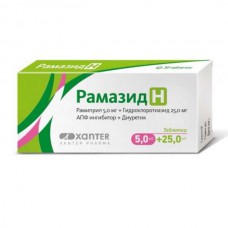Expiration date: 05/2025
Product form, composition and packaging
1 tablet contains:
ramipril 2.5 or 5 mg
hydrochlorothiazide 12.5 or 25 mg
Auxiliary substances: sodium carbonate, lactose monohydrate, sodium croscarmellose, corn starch pregelatinization, sodium fumarate.
Clinical and pharmacological group: Antihypertensive drug
Pharmaco-therapeutic group: Hypotensive combined agents (ACE blocker+diuretic)
Indications
- arterial hypertension (in patients, which shows the combined therapy).
Dosage regimen
Inside. the dose is selected individually. The usual dose for adults - 1 tab. Ramaida N 2.5 mg/12.5 mg per day. If necessary, it can be increased to 1 tab. Ramaida N 5 mg/25 mg.
In case of impaired renal function of mild or moderate degree (QC more than 30 ml/min, serum creatinine about 3 mg/DL or 265 mmol/l), the usual dose of the drug is recommended. When creatinine clearance is less than 30 ml / min, the drug is not recommended.
Side effect
Ramipril.
From the cardiovascular system: lowering blood PRESSURE, orthostatic hypotension, orthostatic collapse, tachycardia, rarely-arrhythmia, angina, myocardial infarction. From the genitourinary system: development or enhancement of symptoms of renal failure, proteinuria, decrease in urine volume, decrease in libido.
CNS: cerebral ischemia, stroke, dizziness, headache, weakness, drowsiness, paresthesia, nervous anxiety, restlessness, tremor, muscle spasm, mood disorders, when used in high doses - insomnia, anxiety, depression, confusion, fainting.
On the part of the senses: vestibular disorders, taste disorders (eg, metallic taste), smell, hearing and vision, tinnitus.
From the digestive system: nausea, vomiting, diarrhea or constipation, pain in the epigastric region, intestinal obstruction, pancreatitis, hepatitis, cholestatic jaundice, impaired liver function with the development of liver failure, dry mouth, thirst, decreased appetite, stomatitis, glossitis.
From the respiratory system: "dry" cough, bronchospasm, shortness of breath, rhinorrhea, rhinitis, sinusitis, bronchitis.
Allergic reactions: skin rash, itching, urticaria, conjunctivitis, photosensitization; angioedema of the face, limbs, lips, tongue, pharynx and/or larynx, exfoliative dermatitis, multiforme exudative erythema (including Stevens-Johnson syndrome), toxic epidermal necrolysis (Lyel syndrome), pemphigus, serositis, onycholysis, vasculitis, myositis, myalgia, arthralgia, arthritis, eosinophilia.
Other: cramps, alopecia, hyperthermia, sweating.
Laboratory parameters: hypercreatinemia, increased levels of urea nitrogen, increased activity of "hepatic" transaminases, hyperbilirubinemia, hyperkalemia, hyponatremia, the appearance of antinuclear antibodies.
Effects on the fetus: dysfunction of the fetus, reducing AD the fetus and newborn, violation of the kidney, hyperkalemia, hypoplasia of the skull bones, oligohydramnios, contracture of the limbs, deformation of the skull bones, hypoplasia of the lungs.
Hydrochlorothiazide
From the water-electrolyte and acid-alkaline balance: hypokalemia and hypochloremic alkalosis may develop (dry mouth, increased thirst, heart rhythm disorders, mood and psyche changes, cramps or muscle pain, nausea, vomiting, weakness; hypochloremic alkalosis may develop hepatic encephalopathy or hepatic coma), hyponatremia (confusion, convulsions, apathy, slowing down the process of thinking, fatigue, irritability), hypomagnesemia (arrhythmia).
From the hematopoietic system: agranulocytosis, thrombocytopenia, hemolytic and aplastic anemia, leukocytopenia.
From the cardiovascular system: arrhythmia, orthostatic hypotension, tachycardia.
From the digestive system: cholecystitis, pancreatitis, jaundice, diarrhea, sialadenitis, constipation, anorexia, epigastric pain.
From the metabolic: hyperglycemia, glycosuria, hyperuricemia, the worsening gout.
Allergic reactions: skin rash, purpura, necrotic vasculitis, Stevens-Johnson syndrome, respiratory distress (pneumonitis, non-cardiogenic pulmonary edema), photosensitization; anaphylactic reactions (up to life-threatening anaphylactic shock).
Contraindications to use
Ramipril.
- hypersensitivity to ramipril and any other ingredient of the drug or other ACE inhibitors;
- an anamnesis of angioedema, including those associated with previous therapy with ACE inhibitors;
- hemodynamically significant bilateral renal artery stenosis;
- stenosis of the artery to a solitary kidney;
- condition after kidney transplantation;
- hemodialysis;
- renal failure (KK less 20 ml/min.);
- hemodynamically significant aortic or mitral stenosis (risk of excessive blood PRESSURE reduction with subsequent renal dysfunction);
- hypertrophic obstructive cardiomyopathy;
- primary hyperaldosteronism;
- pregnancy and lactation;
- age up to 18 years (efficacy and safety not established).
With caution: severe lesions of the coronary and cerebral arteries (danger of reducing blood flow with excessive blood PRESSURE reduction), unstable angina, severe ventricular arrhythmias, chronic heart failure stage IV, decompensated "pulmonary heart", renal and / or hepatic insufficiency, hyperkalemia, hyponatremia (including against the background of diuretics and diets with limited salt intake), conditions accompanied by a decrease in the volume of circulating blood (including diarrhea, vomiting), systemic connective tissue diseases, diabetes, oppression of bone marrow circulation, old age.
Hydrochlorothiazide
- hypersensitivity to the drug;
- gout;
- diabetes mellitus (severe forms);
- chronic renal failure (creatinine clearance less than 20-30 ml / min, anuria);
- refractory hypokalemia;
- hypercalcemia;
- hyponatremia;
- pregnancy (1st trimester);
- lactation.
With caution: hypokalemia, hyponatremia, hypercalcemia, coronary heart disease, liver cirrhosis, old age.
Use during pregnancy and breast-feeding
The drug is contraindicated during pregnancy and lactation.
Application in violation of liver function
Use with caution in case of liver failure.
Application for violations of renal function
The drug is contraindicated in renal failure (CC less than 20 ml/min.).
Use in children
The efficacy and safety of the drug up to 18 years have not been established.
Use in elderly patients
Use with caution in the elderly.
Special instruction
Ramipril.
At the beginning of treatment it is necessary to evaluate renal function. It is necessary to carefully monitor renal function during treatment with ramipril especially in patients with impaired renal function, with lesions of renal vessels (for example, clinically insignificant renal artery stenosis or hemodynamically significant stenosis of the single kidney artery); heart failure.
The risk of hypersensitivity and allergic (anaphylactoid) reactions is increased in patients taking ACE inhibitors and undergoing hemodialysis procedures using an69 dialysis membranes. Similar reactions have been found in apheresis of low-density lipoproteins with dextran sulfate, so the use of this method should be avoided in the treatment of ACE inhibitors.
During treatment with ramipril in patients with impaired renal function, especially with simultaneous treatment with diuretics, may increase the level of urea and creatinine in the blood serum. In this case, treatment should be continued with smaller doses of ramipril or cancel the drug. In patients with impaired renal function increases the risk of hyperkalemia.
In patients with impaired hepatic function due to a decrease in the activity of "hepatic" enzymes, the metabolism of ramipril and the formation of an active metabolite can be slowed. In this regard, treatment of such patients should be started only under strict medical supervision.
Care should be taken when prescribing ramipril to patients on a low-salt or salt-free diet (increased risk of hypotension). Patients with reduced volume of circulating blood (as a result of diuretic therapy), during dialysis, diarrhea and vomiting may develop symptomatic hypotension.
Transient hypotension is not a contraindication to continue treatment after stabilization of blood PRESSURE. In the case of repeated occurrence of severe hypotension should reduce the dose or cancel the drug.
In patients undergoing extensive surgery or receiving other hypotensive agents during General anesthesia, ramipril may cause a blockade of angiotensin II due to the compensatory release of renin. If the doctor links the development of arterial hypotension with the above-mentioned mechanism, arterial hypotension can be adjusted by increasing the volume of blood plasma.
In rare cases, during treatment with ACE inhibitors observed agranulocytosis, erythrocytopenia, thrombocytopenia, hemoglobinemia or bone marrow oppression. At the beginning and during treatment it is necessary to control the number of white blood cells to identify possible neutropenia/agranulocytosis. More frequent monitoring is recommended in patients with renal insufficiency, connective tissue diseases (eg., systemic lupus erythematosus or scleroderma) and in patients, while taking drugs, affecting hematopoiesis. Calculation of blood elements should also be carried out in the event of clinical signs of neutropenia/agranulocytosis and increased bleeding.
in patients with arterial hypertension during treatment with ramipril rarely increase the level of potassium in the blood serum. The risk of hyperkalemia increases with chronic heart failure, simultaneous treatment with potassium-sparing diuretics (spironolactone, amiloride, triamteren) and the appointment of potassium preparations.
When ACE inhibitors are used during desensitizing therapy for aspen or bee venom, anaphylactoid reactions may occur (e.g., hypotension, shortness of breath, vomiting, skin rash), which may be life-threatening. Hypersensitivity reactions may occur with insect bites (eg., bees or wasps). If it is necessary to carry out desensitizing treatment with bee or wasp venom, it is necessary to cancel ACE inhibitors and continue treatment with suitable drugs from other groups.
During treatment with Romazicon N be careful when driving and occupation of other potentially hazardous activities, require high concentration and psychomotor speed reactions (dizziness, especially after initial dose of ACE inhibitor in patients receiving diuretic drugs). Patients are advised to refrain from driving and operating machinery until the response to treatment is clear.
Hydrochlorothiazide
To prevent deficiency of K+ and Mg2+ potassium-sparing diuretics, K+ and Mg2 + salts are prescribed. Requires regular monitoring of plasma potassium, glucose, uric acid, lipids and creatinine.
Overdose
Symptoms: marked decrease in blood PRESSURE, bradycardia, shock, violation of water-electrolyte balance, acute renal failure, stupor, dry mouth, weakness, drowsiness.
Treatment: the patient is given a horizontal position with raised legs, in mild cases of overdose-gastric lavage, the introduction of adsorbents and sodium sulfate (it is desirable to carry out activities during the first 30 minutes after taking the drug). With a decrease in AD - /in the introduction of catecholamines, angiotensin II; with bradycardia - the use of pacemaker. The drug is not excreted in the kidney.
Drug interaction
Ramipril.
Enhances the inhibitory effect of ethanol on the Central nervous system. Taking salt with food can reduce the hypotensive effect of ramipril.
With the simultaneous use of ramipril and other means of reducing blood PRESSURE (eg., diuretics, nitrates, tricyclic antidepressants, anesthetics) leads to increased hypotensive effect of ramipril.
Simultaneous administration of ramipril and potassium preparations or potassium-sparing diuretics can cause hyperkalemia.
Vasopressor sympathomimetics (adrenaline, norepinephrine) can reduce the hypotensive effect of ramipril. In this regard, while the treatment should be carefully monitored blood PRESSURE.
Simultaneous administration of ramipril and allopurinol, immunosuppressants, corticosteroids, procainamide, cytostatics increases the likelihood of changes in the peripheral blood picture.
The simultaneous administration of ramipril and lithium drugs leads to a decrease in lithium excretion, it is necessary to control the concentration of lithium in the blood serum - the risk of toxic effects.
ACE inhibitors can enhance the effect of hypoglycemic agents (such as insulin or sulfonylurea derivatives), which in some cases can cause hypoglycemia. In this regard, the blood sugar level should be carefully monitored, especially at the beginning of the joint application.
Simultaneous use of ramipril and nonsteroidal anti-inflammatory drugs (eg, acetylsalicylic acid and indomethacin) may weaken the hypotensive effect of ramipril. Additionally, concomitant use may cause hyperkalemia and increase the risk of renal impairment.
Simultaneous use of heparin and ramipril can cause hyperkalemia.
Anaphylactic and anaphylactoid reactions to the venom of stinging insects (possibly to other allergens) are more pronounced during treatment with ACE inhibitors.
Hydrochlorothiazide
While the use of digitalis glycosides with thiazide diuretics increases the likelihood of toxic effects of glycosides (including increased excitability of the ventricles) due to the likely development of hypokalemia and hypomagnesemia.
Drugs, intensively binding to proteins (indirect anticoagulants, clofibrate, NSAIDs), enhance the diuretic effect of hydrochlorothiazide.
Hypotensive effect of hydrochlorothiazide is enhanced by vasodilators, beta-blockers, barbiturates, phenothiazines, tricyclic antidepressants, ethanol. Hydrochlorothiazide increases the neurotoxicity of salicylates, weakens the action of oral hypoglycemic drugs, norepinephrine, epinephrine and anti-podagric drugs, increases the cardiotoxic and neurotoxic effect of lithium drugs, the action of peripheral muscle relaxants, reduces the excretion of quinidine. While taking methyldopa may develop hemolysis. Colestyramine reduces the absorption of hydrochlorothiazide.
Hydrochlorothiazide reduces the effect of oral contraceptives.


